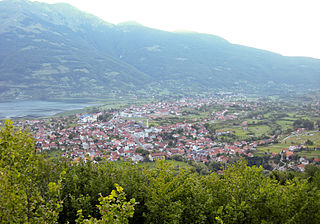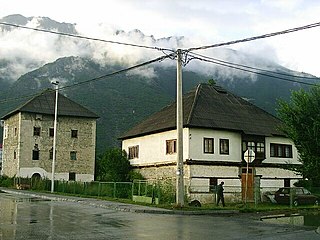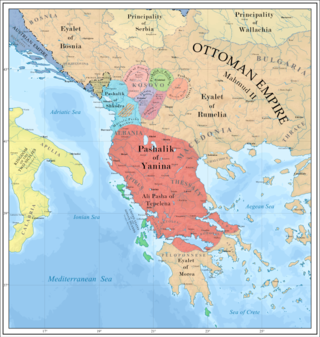Related Research Articles

Kachaks is a term used for the Albanian rebels active in the late 19th and early 20th century in northern Albania, Montenegro, Kosovo and Macedonia, and later as a term for the militias of Albanian revolutionary organizations against the Kingdom of Serbia (1910–18) Kingdom of Yugoslavia (1918–24), called the "Kaçak movement".

Plav is a town in Montenegro in the northern region. It has a population of 3,717. Plav is the centre of Plav Municipality.

Gusinje is a small town in Montenegro in the northern region. According to the 2011 census, the town has a population of 1,673 and is the administrative center of Gusinje Municipality.
Albanians in Montenegro are an ethnic group in Montenegro of Albanian descent, which constitute 4.91% of Montenegro's total population. They are the largest non-Slavic ethnic group in Montenegro.

Ali Pasha Shabanagaj was an Albanian Muslim military commander and one of the leaders of the League of Prizren. He governed, as an Ottoman kaymakam (sub-governor), an area in what is today eastern Montenegro around Plav and Gusinje. He was commonly known as Ali Pasha of Gusinje. He was the leader of the Albanian irregular troops of the League of Prizren against the Principality of Montenegro at the Battle of Novšiće. He was governor of the area of Plav and Gusinje located in a valley between steep mountains.

Hoti is a historical Albanian tribe (fis) and sub-region of Malësia, a divided area located in northern Albania and southern Montenegro. Its geography is mostly mountainous, but some of its villages are on flat terrain near the banks of Lake of Shkodër.

Azem Bejta, commonly known as Azem Galica, was an Albanian nationalist, resistance fighter and rebel who fought for the unification of Kosovo with Albania. He is known for leading the Kachak Movement against the Kingdom of Yugoslavia.

The Committee for the National Defence of Kosovo was an Albanian organization founded in Shkodër on 1 May 1918. It mainly consisted of the political exiles from Kosovo and was led by Hoxha Kadri from Pristina. It existed in looser form since May 1915.

The Attack against Mehmed Ali Pasha, known in Albanian historiography as the Action of Gjakova, was undertaken from 3–6 September 1878 by the Gjakova Committee of the League of Prizren in the estate of Abdullah Pasha Dreni near Gjakova. During the battle Mehmed Ali Pasha, the Ottoman marshal who was to overview the cession of the predominantly Albanian Plav and Gusinje region to the Principality of Montenegro, Abdullah Pasha Dreni, a notable official of the region and former member of the league, many Ottoman soldiers, and volunteers of the Gjakova Committee were killed.

The Begolli family is an Albanian noble family, which rose to prominence in present-day Kosovo in the Ottoman era and were an influential feudal family in the region.
The Neutral Zone of Junik (1921–1923) was a neutral demilitarized border area between the Kingdom of Serbs, Croats, and Slovenes and the Principality of Albania.

Gusinje Municipality is a municipality in northern Montenegro. It is located in the upper Lim valley at an elevation of about 1,000 m (3,000 ft). It was created in 2014, when it split from Plav Municipality. Its center is the small town of Gusinje, and its biggest village in terms of territory is Vusanje. Two of Montenegro's highest mountains overlook Gusinje: Zla Kolata and Visitor. Many of Gusinje's settlements are historically linked with the Albanian Kelmendi tribe (fis). The village of Gusinje developed into a town the 17th century around a fortress built by the Ottomans to contain the Kelmendi. In the 19th century, Gusinje was a developing regional market center. It was engulfed in 1879–1880 in a struggle between the Principality of Montenegro that wanted to annex it and the League of Prizren that opposed it. After the Balkan Wars, Gusinje became part of Montenegro and in 1919 part of Yugoslavia. Today, it is part of Montenegro since its declaration of independence in 2006.
Marenglen Verli is an Albanian historian and scholar. Since 2009, he is a member of the Academy of Sciences of Albania.

Jakup Ferri was an Albanian fighter from Plav-Gusinje who served as a local leader in the League of Prizren's resistance during the Principality of Montenegro's attempt to subjugate his homeland in 1879. He was distinguished in the Battle of Novšiće, where he died.
Ahmet Zenel Gjonbalaj or Ahmet Zeneli (1803–1893) was an Albanian fighter and commander during the period of the Albanian National Awakening in the 19th century who fought against the Principality of Montenegro's attempts to annex his homeland, Plav-Gusinje, alongside Ali Pasha of Gusinje and other Albanian patriots.

Gruemiri is a small historical Albanian tribe (fis) in the former municipality of Gruemirë in the region of Malësia.

The Plav–Gusinje massacres of 1912-1913 occurred between late 1912 and March 1913 in the areas of the modern Plav and Gusinje municipalities and adjacent areas. More than 1,800 locals, mostly Muslim Albanians from these two regions were killed and 12,000 were forced to convert to Orthodoxy by the military administration put in charge of these regions by the Kingdom of Montenegro which had annexed them during the First Balkan War.
Ismail Nikoçi (1876-1919) was an Albanian political activist from Gucia in present-day Montenegro and mayor of that town. He played a significant role in the defense of the national rights of the Albanian ethnic community in Plava-Gucia in the period from its annexation to Montenegro in the Balkans Wars to its final annexation to Yugoslavia in 1919.

Jusuf Mehonjić (1883-1926) was an Albanian leader of the Kachak Movement and a member of the Committee of Kosovo from Šahovici.
The Kachak Movement was a series of Albanian uprisings in Albanian-populated territories in Kosovo, Macedonia and Sanxhak from 1919 to 1927. The uprisings began after the end of the First World War when Kosovo became part of the new Kingdom of Serbs, Croats, and Slovenes. Parts of the Albanian population which resisted Yugoslav rule formed the Kachak guerrilla movement under the leadership of the Committee for the National Defence of Kosovo and conducted military operations and guerrilla-style attacks against Yugoslav soldiers and administrative establishments.
References
- ↑ Verli 2007, p. 178.
- ↑ Dedushaj 1993, p. 123.
- ↑ Lješnjanin 2018, p. 185.